
Yeti SB6c: Reviewed
Sports analysts like to talk about draft years and try to figure out which classes produced the greatest number of standout athletes. In the NFL, the draft of ’83 is often touted as the best ever, and it is hard to refute: Elway, Marino, Green, Dickerson, Kelly – just some of the names picked in that year that even non-believers will recognize. Our sport may not monopolize 20 million TVs every Sunday afternoon like the mighty NFL, but I believe we’re going to look back for a long time on 2014 as a year that produced an unusually high number of great bikes.
And that’s a mixed blessing for a company like Yeti. Long known for their successful race heritage and knack for producing bikes aimed at skilled and demanding riders, this was a year when they made a big move, releasing a couple of Trail/AM bikes that revolve around a reiterated suspension platform called the Switch Infinity Link. First the SB5c which I wrote about in May, and then the SB6c which was an obvious extension of the line, and at least as anticipated as its 5″ cousin.
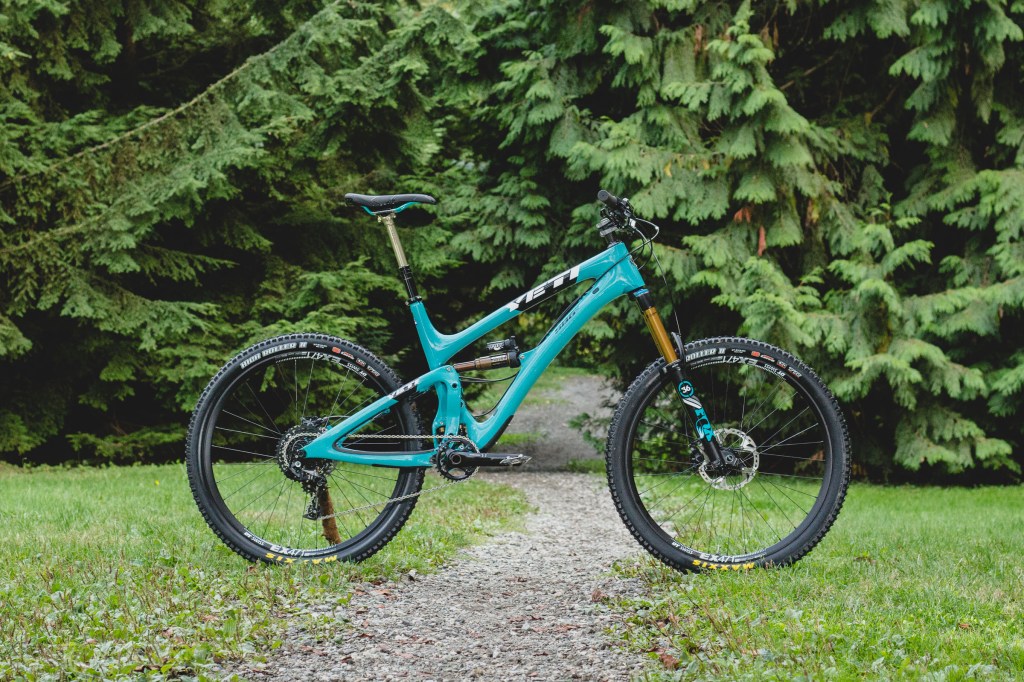
The Yeti SB6c is one of the most anticipated AM releases of 2014 – and that’s in a year where a lot of good bikes were rolled onto shop floors for the first time.
True, they have released their EWS killer into an arena of rabid fans eager to snap it up, but that arena is full of contenders, so no matter how the bike performs on shop floors, there is a lot of competition to contend with (make no mistake, though – I’d bet on them to cover the spread and sell out this year). The NFL can claim more parity between its teams than the other major sports, and I’m declaring 2014 as the year of parity for AM bikes. There are key differences between them all, but the fact remains that the MTB League of 6ers is stacked. Speaking of competition, this is the bike that won the EWS. Well, Graves won, but this was the bike he used for much of the season, and that can’t be taken away from Yeti.
SB6c Details
Like the SB5c (aka SuperBike5″carbon), the 6 is a carbon bike, front to back. The head tube and down tube are some of the thickest I’ve seen and forgive me while I gush for a moment, but there’s something bordering on sensuality dripping off the curves of the frame when you fondle see it in person. I’ve always been a fan of seat tube/top tube junctions that don’t require a brace, and that’s also a sign of solid carbon tech and construction. The rear triangle has flowing, continuous lines, too – this bike is a study in design. Many people think the beating heart of the SB6c – the Switch Infinity Link – looks foreign and therefore is hard to love. I think it’s appealing because it’s indicative of the fact that the Yeti culture is a bit different and they like it that way. You have to be looking to notice it, though, because it’s been tucked away neatly.
For a run down on the bike’s finer details, have a gander at the first impressions article from October. Similarly you can learn more about the Switch Infinity Link here which we dealt with during the SB5c intro.
SB6c By the Numbers
It’s natural to want to compare numbers when bike talk gets nerdy, and obviously they can be informative. However we’ve been poring over them while riding, as well as while talking about these bikes, and the SB6c in particular, and it has reinforced more than ever that numbers can be deceptive. To illustrate that, I put together a chart with some key numbers from some of the bikes we’ve reviewed in the last several months (or are in the process of reviewing):

All bikes are a size ‘Large’ and to be sure, that doesn’t mean the same thing to all companies. Put a different way, all of these bikes fit three of us who measure 6′ – 6′ 1″, so they’re all in the same ballpark. One key takeaway is that the Yeti and the Giant Reign in particular are good examples of bikes that don’t ride exactly like their numbers might lead you to believe. The Yeti’s slightly steeper head angle (and we’re only talking a half degree) and shorter TT makes a pronounced difference when climbing or picking lines at moderate to high speeds.
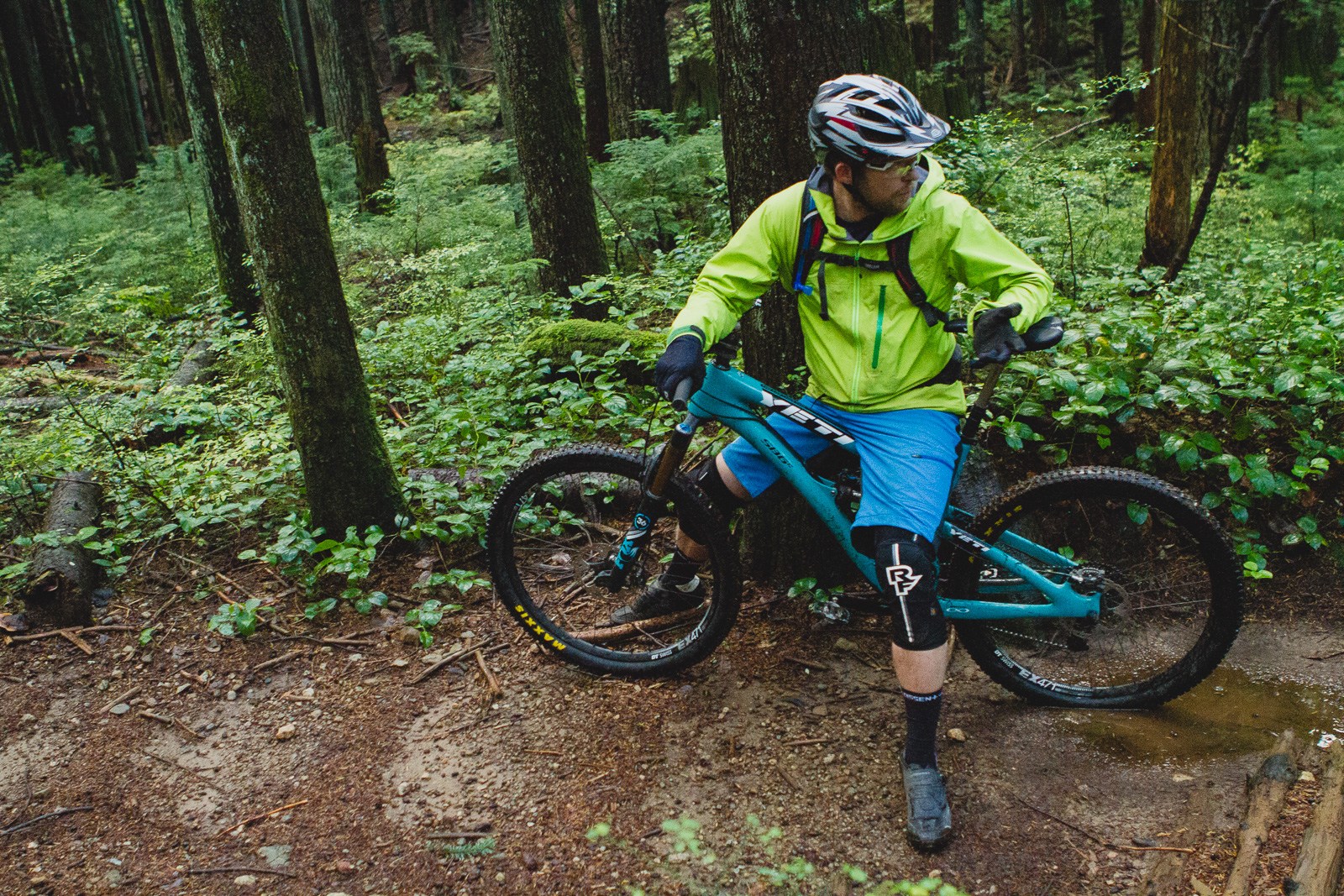
The SB6c elicited a lot of talk about numbers and the complex relationship between variables like wheelbase, head tube angle, and front center. The verdict? Small differences on paper might mean big differences in the dirt.
It’s the wheelbase that’s the kicker, though and Yeti’s is the second longest. At only a tenth of an inch shorter than the Reign, it is more nimble and feels better ridden from over the center or front of neutral, whereas the Giant is the opposite and can be ridden a bit more from the back seat. Neither of these traits should be taken as a negative, they’re merely different. You might love both bikes, but without riding them both, you might also think they felt similar (even before you get into how the suspension works) but that would be far from accurate.
Otherwise the numbers dictate that the Yeti should feel a bit more lively and indeed it does – especially while climbing. This may make it sound like the Giant feels sluggish but that isn’t true at all. The point is that on paper the two bikes are eerily similar but they’re as different as any two bikes in this category that we’ve ridden all year. To make things more interesting, by the numbers the Nomad looks comparatively short but that’s in large part due to the steep seat tube (not to mention the fact that Santa Cruz TTs are usually on the short side) so it pedals competently but feels very planted and stable when descending.
Don’t let this be confusing, just take it as a lesson that you can’t tell how a bike rides by the numbers alone, and speculating about that fact is as useful as diagnosing a head cold by picking through the lint in your belly button. In case this isn’t obvious yet, listen up: geometry is at least as significant as the suspension platform it’s riding on. Everyone’s doing at least a competent job with suspension technology these days, and many brands are doing it really well. We’re finding more and more lately that the thing that sticks out in a review is geometry. Suspension performance is obviously super critical – even more so when you start moving fast and riding aggressively – but if your bike’s geo doesn’t work for you, you’re definitely not going to get the most out of your bike, whereas sometimes you can fake your way through a suspension setup that isn’t quite up to snuff.
Riding the SB6c
I only got to ride the SB5c one time, but it was an eye-opener. Rare is a bike that pedals that well and also has that x-factor on the descents: the “I saved your ass once, and it’ll probably happen again” feeling was palpable. The SB6c has the same pedigree, obviously, and the word balanced is apt. Here, though, is where the geo vs. suspension issue comes into play, although the issue stemmed more from the front of the bike than the back.
The latest Fox 36 has garnered a lot of acclaim, but we have had mixed results. Our tester that came back from the launch in April certainly got to the point where it performed well but it never felt as good as we presume it could. After some fiddling I felt like it was riding at a nice point in its travel, provided good traction, and did what it’s supposed to do, but I wasn’t smitten. So when the fork on the SB6c felt similar, it just seemed to me that that’s the way the 36 was tuned. It performs though and honestly I was riding well and felt confident with it, but the love ended there. Then Cam got on the bike for a while and he was not loving the fork in the least and that might be putting it charitably. We took it for service but it was no better – clearly something bigger was afoot. This is as good a time as any to share Cam’s impressions of the bike.
Ride Impressions – Cam McRae
I was pretty excited to get my hands on the SB6c. I never had the chance to ride the SB66 but every rider I know who tried one gushed. And the 6c seemed to balance simplicity and innovation with a rare elegance. At least in person. Many who first see the bike online – or hanging on a wall even – aren’t pleased by the aesthetic, but in person most agree that it’s a smooth, syrupy sculpture.

We spent a good amount of time on the SB6c in North Vancouver, as well as on trips to Penticton, Ashland, and Santa Cruz. Some impressions were similar, but the fork left Cam wanting whereas I was able to get along with it a bit better.
I noticed the smooth and active rear travel as soon as I put rubber down here on the Shore. Both up and down. In fact the climbing prowess of the 6c is of particular note. Pete and I selected some tough technical singletrack climbs and did some back to back testing with a Giant Reign Advanced, a solid climber to be sure. While the Reign digs in really well, the Yeti’s rear end is more supple when power is applied and it transfers juice like few other bikes I’ve ridden.
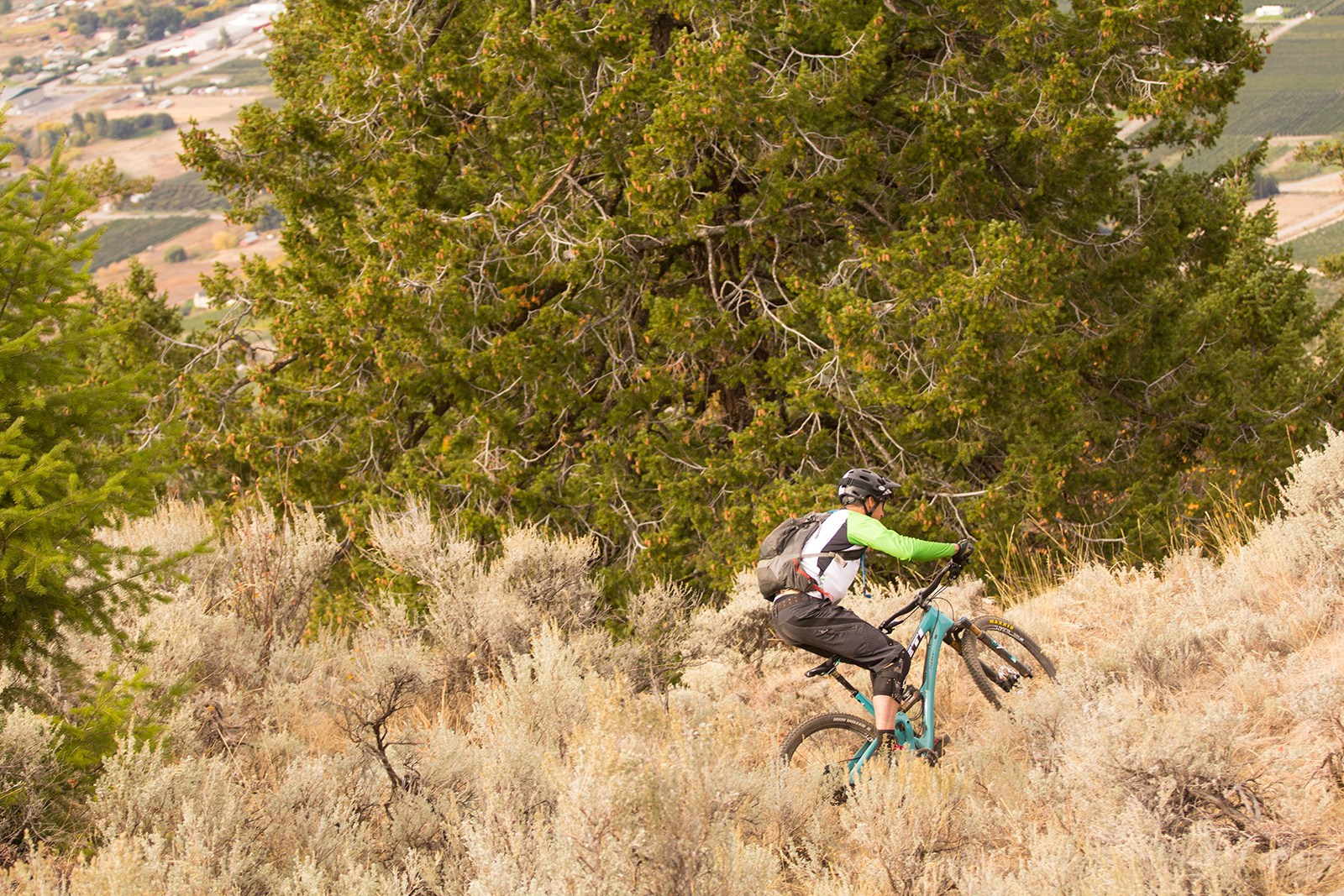
Best results were achieved with rider bias a bit forward of center. Hit that spot and the SB6 feels lively. Photo: Pete Roggeman
My first impressions of the Yeti descending were coloured by the Fox 36 fork and how it was performing. We eventually discovered that early versions of the fork were judged to be valved too firmly for most riders. Somehow the fork on our test bike was shipped with that early valving. With the fork like this I felt that I had to have my chin ahead of the handlebar to get the bike to perform. And there was no middle spring rate that would have adequate support and still get into the meat of the travel. This was compounded at times by a known issue on the 36. Under certain conditions, perhaps influenced by altitude, the lowers can get pressurized making it underperform (a fix involves sliding some 35mm negative film between the dust seal and the lower leg and then cycling the fork to allow air to escape).
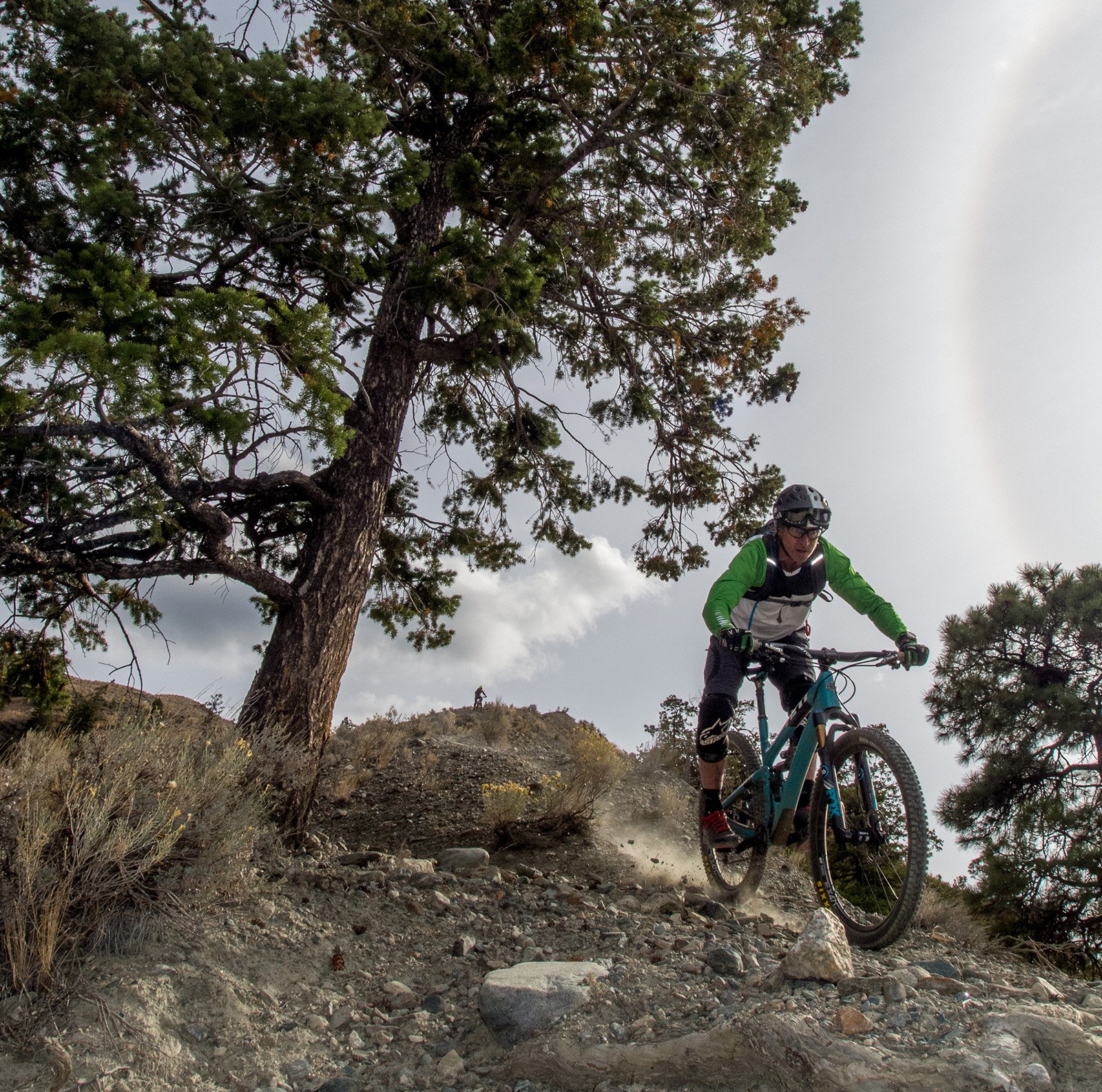
Penticton’s vineyards and lakefront properties give way to some seriously steep and rowdy riding – perfect for testing AM bikes. Photo: Johnny Smoke
We stopped in with the bike at the Fox office in Scotts Valley and Jordi Cortes installed the correct cartridge with the final valving. And the bike started to shine – in most situations. Since the beginning the bike hasn’t felt amazing to me at speed – particularly when presented with high-frequency, square-edged impacts. It has been solid in almost every other situation but, even after the fork was dialled and feeling great, this persisted for me. I double-checked the sag, adjusted pressure up and down, tried descending with the Fox Float X CTD rear shock in Trail mode, but I never got there. Braking bumps and chatter were a particular challenge. It felt more like a shock issue (set up or otherwise) than anything to do with the configuration or the geometry, but without another shock to swap in I can’t be sure. Unfortunately I didn’t figure out that things weren’t as they should be with the rear suspension until the fork was sorted out – and I was only able to ride the bike a couple of times after that.
In truth I’d like more time on the bike, because I feel like there are stones unturned – but it appears that it’s time to get the SB6c back. If we manage to hold onto it longer I’ll keep trying to sort it out and get back to you.
So the banjos dueled a bit and one seemed to be missing a string. One thing the guys at Fox told us is that the 36 we had was tuned more like Graves and other pros like it, so it suits heavier and more aggressive riders. I am one of those things when compared to Cam, sometimes maybe both on a good day, whereas he rides more smoothly. So, the extra 15 pounds I carry may have made the fork work a bit better for me – particularly in high speed sections, because I never felt like the fork was holding me back there. With that said, we’ll be spending more time on Fox 36s over the next while and will be sure to update our thoughts on it, because it seems certain that so far we haven’t been on one that was running at 100%.

I was able to get the travel band on the Fox 36 all the way to the top, but Cam didn’t have as much luck getting full joy out of the fork. Ours was valved for heavy or aggressive riders. We’re looking forward to spending more time tweaking one and will be sure to report back.
During the test period, we’ve ridden the Yeti SB6c on the the Shore, with its varied terrain – steep and slowish as usual but also lower grade and fast if you pick your spots – as well as in Penticton, where we rode some of the most sustained steeps anyone had ever seen anywhere, and then in and around Santa Cruz and in Ashland, Oregon – two places where speed mixes well with flat corners as well as nicely sculpted berms. Partly due to the fork, Cam didn’t ever feel like the bike sang for him at speed, but I felt comfortable on it within 2-3 rides. It never was as burly feeling as the Reign or Nomad, but that didn’t hold me back either, and I remember remarking that it felt at least as fast as those two bikes, but you sure as hell had to be actively riding it and picking lines. If I felt good the Yeti would reflect it, but on a bad day, it wasn’t as rewarding. Livelier for sure, though, and if you like seeking out hits and doubling things not everyone sees, this is a bike that caters to that attitude.
I don’t recall ever bottoming it hard, but it also isn’t as plush feeling as the more active Reign Advanced or the Nomad – rather the back end felt fairly balanced with the front for me, meaning it felt tuned to go fast, and when I did, I found it would skip nicely over high speed bumps. When push came to smash, it never hung me up and sent my chin racing toward the stem, nor have I felt the dreaded wallow from a g-out in a turn or a missed weight shift in a depression. Safe to say then that I was pretty happy to endure a slightly firm overall feel in exchange for performance that really feels designed to go fast. Given that that’s how Yeti is marketing this bike (i.e.. with a lot of race-inspired verbiage), the only surprise was that in their case the marketing isn’t hyperbolic; it’s lively and responsive but you do need to mind the leash.
Climbing on the Sb6c was almost good enough to fool me into thinking I wasn’t on a 6″ bike. In fact this bike climbs better than any other 6-inch bike I’ve ridden, whether that was on smooth sections that emphasized a good pedal stroke, or steep technical climbs where its traction and sure-footedness rewarded patience and good handling. This is something I felt on the SB5c as well, even with the shock wide open in Descend mode. Switch Infinity, according to Yeti, is designed to provide anti-squat in the first portion of travel in order to climb well, and then after the inflection point of the link, it flips (in its way) into descend characteristics, trading pedaling platform for big hit compliance.
It’s usually hard to claim something feels exactly like a company claims it will, but I can’t deny that the SB6c pedals surprisingly well, and also descends with confidence and precision. And if we can get that fork fully dialed, well, we just might have an MVP candidate on our hands.
Odds and Ends
I questioned whether the Switch Infinity Link’s placement and configuration would be a mud-catcher and it is somewhat, however it also rinses out easily and hasn’t proven to be tough to clean. Different it may be, but not much worse for attracting debris than any number of other linkages.
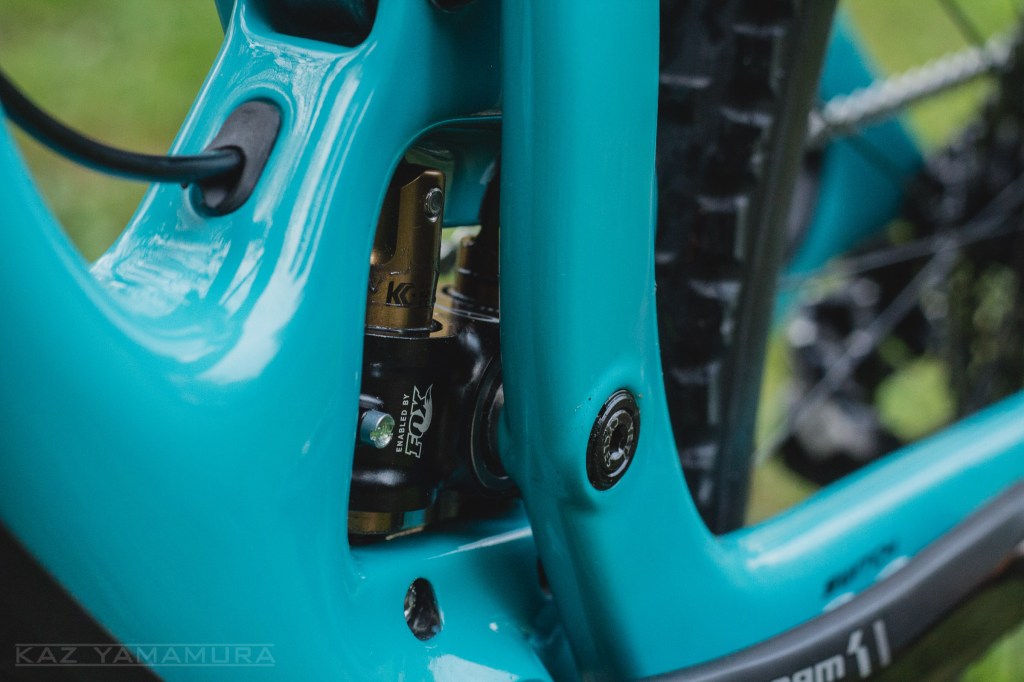
Questions abound regarding the Switch Infinity Link’s durability. Yeti and Fox beat the shit out of it over the last three years, so we don’t expect to hear about any issues.
The XT brakes on the Yeti felt particularly sharp – almost too sharp at times – but that was testament to the Guide RSCs I’ve been riding on the Nomad of late. They are very different brakes, and I like them both, but switching back and forth was an adjustment.
The Thomson Elite Covert dropper post is a winner. The bar-mounted lever tucks away nicely and is easy to operate, and the only trouble we had with it was due to a frozen line – something that can happen to any cable-activated post or shifter that is hosed down and then subjected to freezing temps before it has a chance to dry. Happens quite a bit at this time of year, so watch out for that.
The High Roller II’s continue to work better for me than some others here on the shore, but I do find the rear wears out more quickly than other tires I’ve run the last few years. After 10-12 rides the grip starts to decrease noticeably.
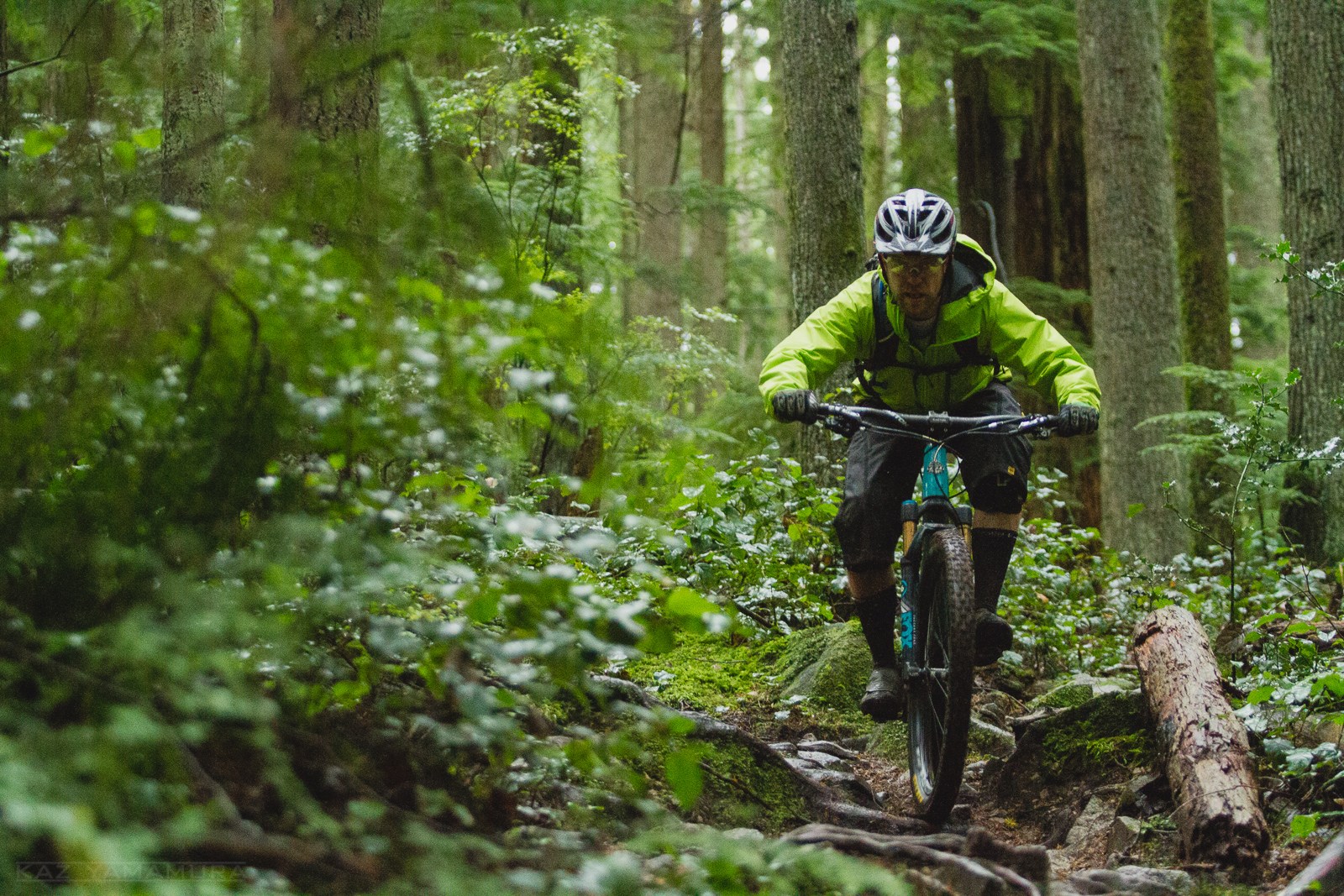
The Easton Havoc 35 Carbon bar is 800mm wide – which works for me – and felt precise and strong. However when cycling the fork you could feel it flexing noticeably at the ends. Not a bad thing but a bit surprising. And truth be told a little flex doesn’t hurt; after our recent road trip in the US, 5 straight days of riding had my wrists feeling a bit sore, and I’m left wondering if a stiff handlebar (not the Easton – it was a SixC 35) was at least partly to blame.

SRAM’s XO1/X1 drivetrain was more than up to the task, as usual, and we definitely rode the SB6c through a good amount of rain, snow, and mud, in quite a few different places.
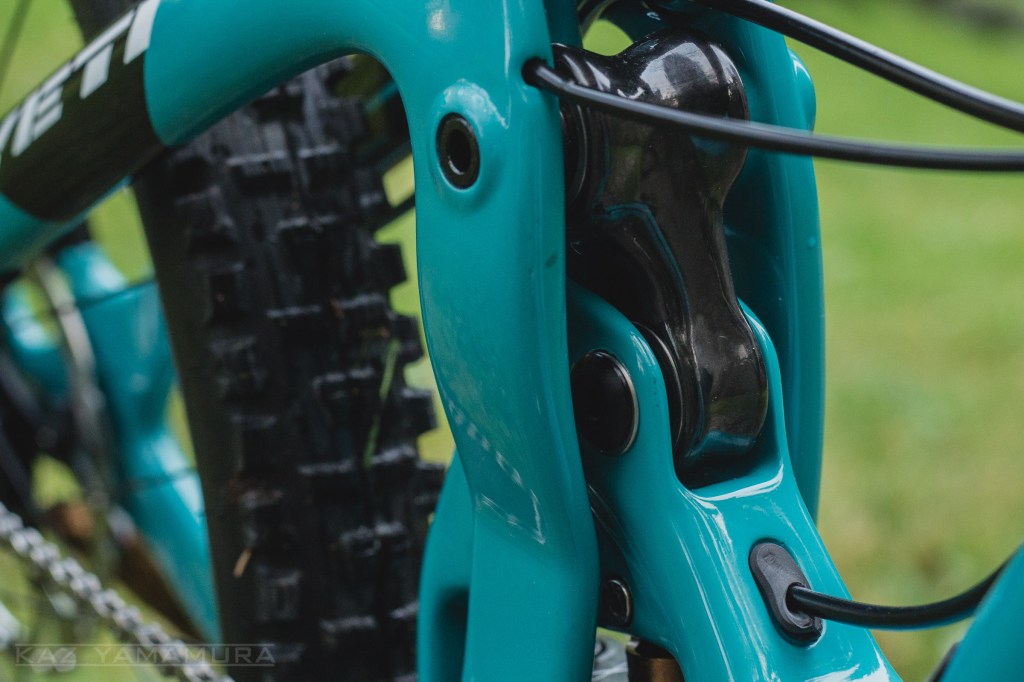
Internal routing includes a provision for a stealth dropper post. The Yeti is dead sexy – and dead quiet. Design and engineering seem to have come together very nicely for their new SB line.
The Yeti SB6 Carbon we tested came with the X01 build kit, which weighed in at 29.5 lbs (incl. XTR trail pedals) and retails for $7,399 USD / $7,699 CAD. They’re available in stores now and damn would one ever look sexy under a tree.
Is 2014 the best MTB grad class we’ve ever seen? And is the SB6c your vote for valedictorian?

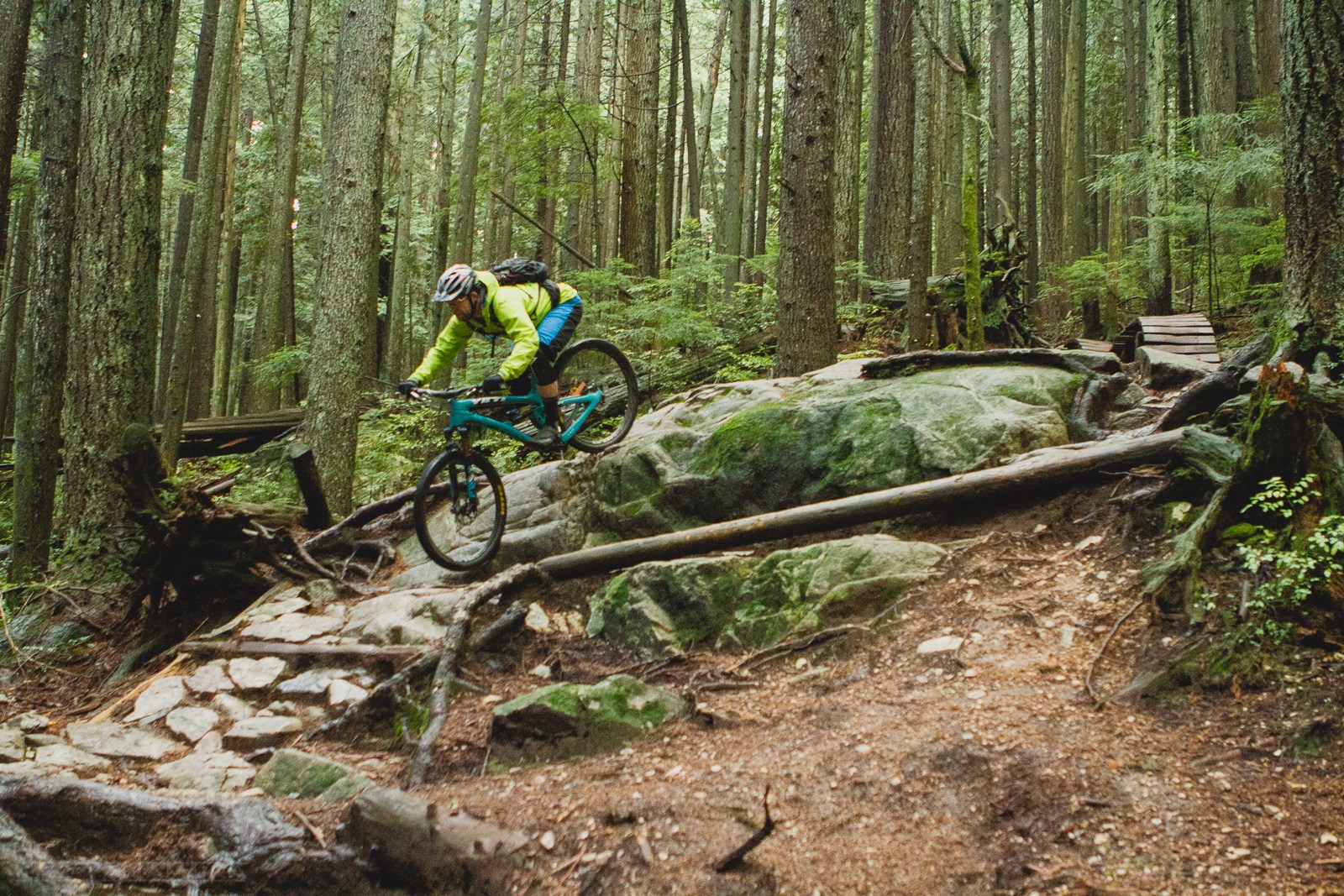

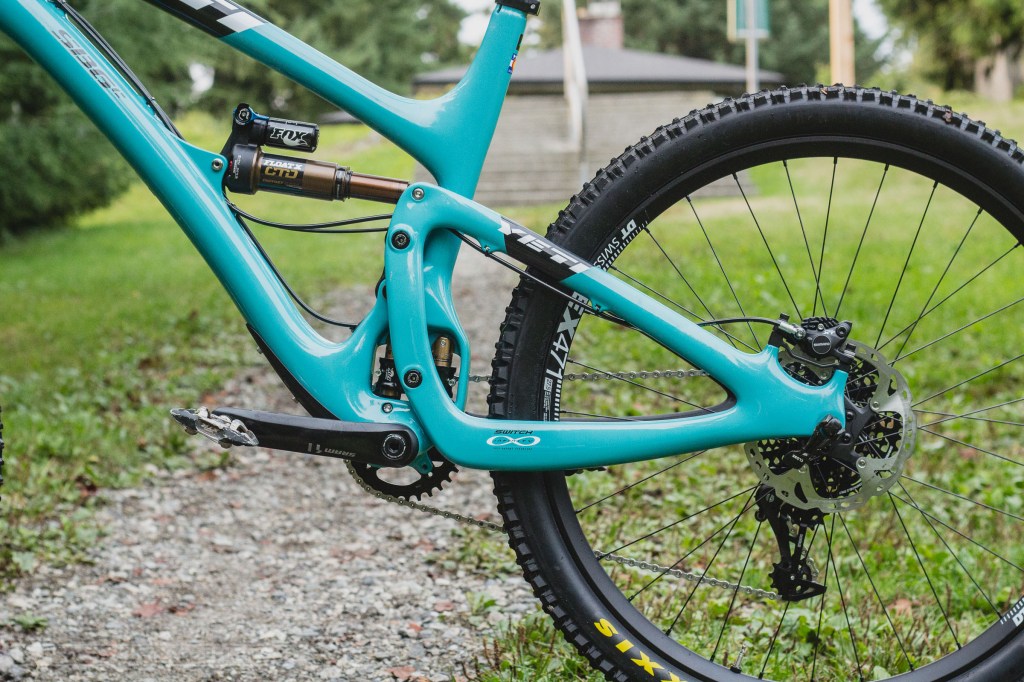








Comments
SDA
8 years, 1 month ago
I am looking at the SB6c - was wondering about the sizing. I am 5'11" so essentially in between a medium and a large. Any thoughts on which size I should go for?
Reply
OldManBike
9 years ago
C'mon, you guys can't have been trying very hard. All the other media guys broke their SB6Cs. What gives?
Reply
Pete Roggeman
9 years ago
I didn't get enough riding time on it, obviously!
Reply
Morne
9 years, 3 months ago
Can you comment on sizing of the three bikes? Im 6.1 with a 33″ inseam, and Im concerned the nomad large is to small( and the XL to big), so Im looking at the reign and the yeti, although I like the way the nomad rides.
Reply
Cam McRae
9 years, 3 months ago
I wouldn't say there's much difference between the three MM. The Reign has the longest TT but Pete and I are both roughly your size and all three bikes fit us just fine. What measurement are you concerned about?
Reply
Morne
9 years, 3 months ago
Thanx Cam .Im concerned about the Nomad TT AT 24″ being on the short side for what Im used to (XL devinci troy), leaving me pitched over the bar a bit when pedalling, as my seat is quite high, but at the same time these bikes are getting long in the wheelbase, which makes slow tight tech difficult. Its hard for us mortals to get to try all these bikes before putting down the money, so we tend to rely on the opinion of others. I've ridden the large nomad once and the patrol, the nomad felt smallish and the patrol felt like a sled.
Reply
Pete Roggeman
9 years, 3 months ago
Hey moon, FYI I'm 6'1″ like you and have a 32″ inseam, so we're pretty similar. I recently heard from an industry guy down in California (shredder) who is probably closer to 6′ 2″ and has had a few Santa Cruzes. He just picked up a Bronson in XL (he used to run L) and put a 35mm stem on it. He had been concerned it would take getting used to but says he settled into it right away. Different bike but might be an option for you - size up to XL and get a really short stem.
Tight tech will suffer a bit but I'm used to it now even in tight stuff and have learned to make it work.
Reply
Cam McRae
9 years, 3 months ago
In my pursuit of sorting things out I went for a fairly big ride today. I felt like things are finally coming together both front and rear. It seems like I got used to riding the front so much when the fork wasn't working to my liking that it took me some time to back to a more balanced descending stance, Today was the first time I felt like I could get a little loose on the bike and have fun on the edges of the trail. Definitely moving in the right direction - but suspension fine tuning will continue.
Reply
Taz
9 years, 3 months ago
Can't say I've seen a bike savaged by a mag before.. Usually it's all fluff and hype. Thanks for the honesty. More mags should adopt this standard.
Reply
DrewM
9 years, 3 months ago
Interesting that you thought the review was a ["savaging"]. Other than the fork issues, I thought the conclusions were pretty predictable based on past reviews by the two authors. Particularly, if I may be so bold as to para-one- phrase, that Pete found the rear suspension too stiff but liked the suspension performance better than Cam did.
Yeti's SB rear suspension design is very linear and for maximum performance needs to be run very firm (sag) with the fork set up similarly (firmer & faster). They climb very well, and they are relatively "dead" feeling bikes when descending ("Active, yet firm racy feeling" as Steve said). The performance is very good especially when the bike is being pushed hard and if you prefer a stiff, "racy', feel, or a longer travel bike with the get-up-and- go of a short travel bike they are a great choice.
If you prefer to ride bikes that are very soft off the top, have good mid- stroke support, and ramp very hard in the end (a la Specialized Enduro, Nomad V3) you probably won't like the Yeti SB.
If you prefer to ride bikes that run a lot of sag (~30%+) and sit in a "pocket" while pedaling (like the Giant Reign, Intense Tracer?) with your fork set-up to match (Pike @ ~25% sag?) you probably won't like the Yeti SB.
If you want a bike that can be ridden very fast/hard with aggressive "Enduro" geometry but you prefer a more linear suspension set-up and prefer to run your suspension firm (like a Yeti) then the Yeti SB may be the bike for you!
Reply
Pete Roggeman
9 years, 3 months ago
Well said, Drew. I didn't think we were savaging the bike either - in fact while Cam hasn't yet had many rides where he felt it was really singing for him, I'd hoped that my thoughts reflected something along the lines of what you said above about the Yeti's feel - it may not be what I prefer on a personal level, but as far as the way it rode and performed it was very impressive to me. I'd be more than happy to have it as my regular bike.
I should note here that we are going to keep the bike just a little while longer so we can update this review after we've spent a bit more time getting the fork sorted out.
Reply
Ryan
9 years, 2 months ago
this is one of the best descriptions of differences between platforms and bikes I've read in ages. The review was also more informative than most guff.
I'm really keen to read NSMB review of the HD3, as it, the SB5c and SB6c are at the top of my list. I'm trying to get a demo on the SB's, I got a demo on the Reign and hated it (was a low spec alloy one with suspension poorly setup I think, but nevertheless was way more sluggish and DH feeling than I want) which makes me think the SB's are the way to go. But not really sure where I need to be in terms of travel length (e.g. sb5 or sb6) given how 'stiff' the platform is (the Reign felt like too much travel, too wallowy, or both for my taste)
Reply
DrewM
9 years, 2 months ago
Thanks!
Personally the SB5 would fit the bill over the SB6 -- shorter travel bikes with aggressive geometry are my preference. Not that you can take too much from what sponsored athletes do, but given some of the courses the Yeti team is choosing to race the SB5 on instead of the SB6 you know it is capable.
Hopefully you have a chance to demo one. If you are local to the lower mainland I believe that Fabian @ Kinetik Cycles stocks both models and he is a really nice guy to deal with.
Reply
awesterner
9 years, 3 months ago
Kudos for the honest review guys. Switch Infinity doesn't seem like a reinvention of the wheel, more a refinement of the Eccentric. Then it comes as no surprise that it has traits the the Switch link had. Active, yet firm racy feeling, a bit firm under braking. Pete describes what a lot of us felt with the SB66, yet in a updated package.
Reply
Yeti_freak
9 years, 3 months ago
I appreciate that journalists test bikes with stock builds, identical to what one may buy at his or her local shop. However, it seems too often that I read a review where the character of a certain frame is tarnished (or falsely praised) by the performance of the stock suspension. Every rider knows the importance of properly dialed suspension, as it can completely alter the feel of any bike.
So my question is; why are there not more reviews where the frame itself is the focus? I'm fairly confident that all the journalists reviewing these AM bikes do own their own mountain machines. And, like everyone else, I'm sure they have their suspension dialed to a high degree of personal preference. So why not grab that favorite fork and shock and throw them on the frame in question? I know the suspension may need to be tweeted to better cope with the frames geometry and leverage attributes, but at least it would be familiar.
Again, I understand that in this case the bike as a whole was being reviewed. However, I feel it would be much more informative to read about the frame, and only the frame. If I want to know about the new 36 I can read a review about it, and only about it. If I'm looking for a dropper post I don't need to read a review of an entire build just to find out about it. So why is this not the case with a new frame? I could be way off here but I would guess many of the potential buyers of this bike will purchase just the frame (once it becomes available) and build it up with pre decided personal preference components (say that five times fast).
It seems to me that too much of a new frames merit depends on the accompanying componetry. I don't want to read about how the fork valuing was off, or the effectiveness of the dropper post lever (no offense at all to the author of this review). I can bury myself in a landslide of such reviews if I wish. What I want to know is if I buy this frame to replace my aging one, how great or poor will it be?
Nevertheless, great review of a stunning bike. I do think it is especially important to note the performance of the stock shock as it is very often the case a frame cannot be purchased sans-shock.
Reply
Pete Roggeman
9 years, 3 months ago
It's a fair point, Yeti-freak. Reference our Nomad review and you'll see exactly what you're asking for. In that case we were given a bike as a long term test platform, and had time to do some swapping out of suspension components (and have more coming for the future). However in this case, we simply haven't had enough time with the bike. And, the glib answer is: "because that's the way it's being sold" at least for now, before it's available as a frame only. For every buyer like you who plans to buy a frame and hand pick each part, there are 10 that might wish they could, but ultimately won't - for those 10 to 1, hearing about the individual parts does matter, especially because the parts that were chosen for a particular build were done quite deliberately by the product manager.
So, long answer made short: I hear you, and sometimes we do/will do that (same with other publications) but often it either isn't feasible due to time, or relevant to the majority of readers.
Don't think I'm being dismissive, though - what you're positing here is exactly the reason that we sometimes take on long term test bikes.
Reply
Vonmeister
9 years, 3 months ago
Brutal. Glad I didn't buy one.
Reply
Cam McRae
9 years, 3 months ago
I'm not sure why you are calling it brutal - but that hasn't been our experience. And I'm getting along better with it by the day. If I was dropping cash on a frame right now the SB6c would be on my short list.
Reply
Benzo
9 years, 3 months ago
2003 NHL draft…..best ever.
Reply
Brumos
9 years, 3 months ago
Nice looking bike no doubt, but one of the most important aspects (for me) of owning a bike is ease of maintenance especially here on the Shore. With that in mind, this design looks like a ton of work to pull apart the pivot(s) for cleaning/regreasing and the Swich infinity link location is a magnet for all sorts of debris. This only becomes apparent after a season of riding in all conditions, sadly for most bike reviews the time spent with the bike is not long enough to truly determine ease of maintenance.
How a bike rides/feels on the trail (ride characteristics) is very important. I would argue that the long term enjoyment of a bike is just as important. How annoyed would you be with having a constant creaking or discovering play in a pivot axle that you just can't get rid of?
Reply
Pete Roggeman
9 years, 3 months ago
Here's what I know: the Switch Infinity Link should not require any maintenance. Those seals have been tested through millions of cycles. Yeti VP/Engineering lead Steve Hoogendoorn is still riding the 3 year old prototype and the original Switch Infinity Link is going strong. See my article about the SB5c to learn more about how Fox tested it. Looking at the pivot hardware, honestly it's no worse than most, and better than many. Obviously we haven't had enough time on the bike to comment on these things from a long term perspective, but after 2.5 months, nary a squeak. in other words, your concerns are valid, but I don't see any additional risk/cause for concern with this design than with most/all in the same category.
Reply
Rdot84
9 years, 3 months ago
So the question arises. Yeti sb6c or Ibis mojo hd3. Then there is the Devinci Spartan or Transition Patrol. Looking for an all rounder playful bike biased to downhill for Park days…. Lots of park days and the occasional enduro race. Suggestions?
Reply
Fisheggs
9 years, 3 months ago
Nomad 3
Reply
Rdot84
9 years, 3 months ago
I thought of the Nomad 3 but I heard it pedals like poop. Correct me if I'm wrong because that will put the Nomad at the top of my list. I still need to be able to ride around some flatter terrain on my local trails.
Reply
Perry Schebel
9 years, 3 months ago
though i only had one ride on the thing, the patrol was a surprisingly capable all-rounder, and one of the funnest bikes i've ridden - a very poppy / playful character. plus $1k+ cheaper than the carbon competition. definitely worth a test ride.
Reply
Fisheggs
9 years, 3 months ago
I've heard just the opposite - that (for a bike in its class) it pedals really well, and I'd be surprised if it didn't. I think the review on this site said that, and also same on PB. I'm building one up right now, 1st ride will be this weekend, so I'll add a comment after some time on it.
Reply
Pete Roggeman
9 years, 3 months ago
You won't find, as you put it: "an all rounder playful bike biased to downhill for Park days" that also pedals really well on flat terrain compared to a smaller bike. That's just the reality. NO bike does everything perfectly, so decide if you want to sacrifice a bit of pedaling/uphill performance or a bit of downhill performance - that determines the category from which you'll be choosing.
The Nomad pedals well…for a big bike. You may learn more by reading the review we published: as well as some others. The Yeti pedals better. I haven't got time on the HD3 yet.
Reply
DMVancouver
9 years, 3 months ago
Have you tried the Scout as well? For someone who doesn't ride a lot of park but still wants a bike that can smash a Shore or Sea to Sky enduro race while not feeling like a cumbersome beast, the choice between these two would be tough.
Reply
megrim
9 years, 3 months ago
@rayfordjr:disqus - I bought the Nomad 3 a few days after it came out and I am constantly blown away at how well this bike performs in every situation. I think it pedals very, very well, especially considering it's travel. I can't compare it to the SB6c, but I would think that the almost 15 mm of travel would make a big difference. This Yeti looks like a lot of fun for pedaling to and riding almost every line on the shore.
Reply
bkbroiler
9 years, 3 months ago
It pedals VERY well.
Reply
bkbroiler
9 years, 3 months ago
I've got the SB5 for trail and 90% of my riding and the Newman for park. I'm faster through most DH (flow) sections on the Newmad than my V10. The SB5 w a pike is a real balanced, killer bike that has a "sport/efficient" feel that loves being pushed beyond it's stated purpose. If that helps
Reply
AndrewR
9 years, 3 months ago
Whoever told you a Nomad "pedals like poop" has: a. not been on a Nomad 3, b. has only ever previously ridden a hard tail, or c. had the suspension set up too soft. I have been on my Nomad for four months now, ridding about 80 km of tech trails per week and it is one of the best pedalling bikes I have ever been on (SC Bullit 2002, Blur TRc 2012, Nomad 3). I get to try other bikes through work and it pedals as well or better than the Giant Trance, Reign (2013 models) and the Norco Range (2013 model). It is a pretty precise bike however so set up (suspension, saddle posiition, stem length, stack height and handle bar width) for body size and riding style is pretty important.
Reply
Rdot84
9 years, 3 months ago
Thanks for the honest feedback. I'm leaning toward the Devinci Spartan but the Nomad and Transition are a close second after doing some research and they both have lovely threaded bb's. Most likely going to come down to price when I'm ready to pull the trigger.
Reply
Pete Roggeman
9 years, 3 months ago
Killer quiver.
Reply
Daddy Fras
8 years ago
Hey, firstly, apologies for cutting into a year old thread - I just couldn't find a better place to ask this!
I've been riding a Nomad 3 for nearly a year now - it's an amazing downhill bike. I found that the Monarch didn't really do what I wanted it to (that may have been a hangover from the feeling that it underperformed on my previous Process 153) so i fitted a CCDB air CS, and have been loving the way it gobbles very rough terrain, and generally handles any trail with very good manners (I'm sure it makes me feel like a much better downhiller than I really am. But there's a catch. I race this thing quite a lot, and here in NZ, almost all of the enduro stages will treat you to 20-30% of flat or uphill riding. Every time I smash some grade 5 technical downhill, feeling like it's the fastest I've ever ridden in, only to feel the places drop away on some climb or 2km flat sprint at the end of it.
So, today I had the chance to ride an SB6c, and good lord that thing can pedal. I had the loathsome strava running, and kicked all of my uphill times by a large margin - without really trying, and feeling fine at the top. Interestingly, I had a 2016 5010 to demo at the same time, and that, by comparison, felt sluggish on the same undulating climbing trail - in fact, it felt like the Nomad to climb.
I ran the SB6 down a familiar (albeit wet and slippery) downhill, and found it quite skittish. I know that some time tweaking would help it be more composed, but if I attempted to use the brakes at any time in the rough stuff it just spanked me for it and told me to let go. Which I did, and it just skipped over the top in what I perceived to be a vaguely scary way - it didn't have anything like the "oh yeah, we can do that - just point me however you want and I'll take it from here" attitude of the Nomad.
So, what I'm driving at here is this: I love my Nomad to bits, but can you think of any way to make it respond better when it comes to sprinting time (I'm thinking of trying a dhx2 - I hear the coil helps the Nomad sit up better in its travel), or if I want a more spry race bike that handles the steep stuff, do I just need to get used to the Yeti? (or can you recommend a different frame that might tread this line a little better?)
Cheers, and sorry for the long-winded explanation (and I appreciate that you probably don't want to answer this, but, I value your opinion).
Reply
Pete Roggeman
8 years ago
Daddy,
In a certain sense, you're asking to have the cake you also want to eat. It's really hard to compare bikes like you have above (in not too many words, so I have to make assumptions here) without considering whether they were setup similarly: suspension, tires, pressure, etc. Tire pressure alone and inferior rubber could give you that skittish feeling in the wet. As for the Monarch, I wonder how much you've played with the tune? Did you add spacers? I've run as many as six in the Monarch Debonair Plus on the Nomad and it makes a notable difference in the mid stroke both at high speeds on the way down as well as staying supportive and providing traction while climbing. So…try that before switching bikes because that's the cheapest and simplest option available to you. Here's an article I wrote about it:
Ok, that said, the SB6 simply goes uphill better than the Nomad, and I've found the Nomad feels better going down - across a variety of setups on both bikes (but I have way more time on the Nomad even though I recently rode a differently-equipped SB6). The thing about the Yeti is that it's truly race- bred, so it feels like it. I didn't feel quite as confident on it as the Nomad, but it was quick and it gobbled stuff. For racing, it might be my choice. In your case, with stages that feature 20-30% pedaling, it's the obvious choice. You'll gain more time with less risk of crashing if you focus on the flats and climbs rather than trying to push 10% harder on the way down. So if it's between both bikes and you've exhausted tuning options with the Nomad and aren't yet happy, race the Yeti, and tune it to enhance your weaknesses, not your strengths (or the bike's weaknesses for you, if you know what I mean) and you'll get the best race times. I do not think a coil shock will give you better pedal performance on the Nomad - and certainly not better than my suggestion of playing with your spacers in the air can.
Hope that helps. Happy to nerd out some more on it with you though.
Reply
Cam McRae
9 years, 3 months ago
I would add the Reign Advanced to that list.
Reply
Raymond Epstein
9 years, 3 months ago
Banshee Rune V2…the OG of these rigs.
Reply
Fisheggs
9 years, 3 months ago
really good review. thanks. I especially appreciate the comparisons b/w bikes in same class - very helpful info. I had the same thoughts on the Fox fork and XT brakes - the Fox was nice but I still prefer the feel of the Pike; and XT brakes were OK, but modulation is just not as good as many other brakes like Hope, Formula. First world problems……
Reply
Pete Roggeman
9 years, 3 months ago
We're trying to add more contextual info to our reviews so that when we say a bike does something well, we can also say "compared to x or y".
Reply
Cr4w
9 years, 4 months ago
That was a great review. I'll be curious to see if there's a SB9c coming.
Reply
Pete Roggeman
9 years, 4 months ago
Thanks - that makes two of us. Given that they released a 4 inch ASR Carbon earlier this year, it would be logical that the next release would be a new DH bike…but I don't know anything that you don't.
Reply
SteveL
9 years, 3 months ago
Looks like there is a DH bike in the works -
Reply
yeti115
9 years, 4 months ago
Many thanks for the review guys ! I'm glad I have a Pike waiting for the frame…
Let's see if my 130 lbs managed to move properly the rear supension.
PS : how does the Giro enduro shoes go with the frame ? OK, I =>
Reply
Pete Roggeman
9 years, 4 months ago
You'll be fine, I'm sure. Just make sure you get the right shoes to go with the bike 😉
Reply
Shane Bracken
9 years, 4 months ago
Are you using the 3C compound or the 60A on the HR2's?
Reply
Pete Roggeman
9 years, 4 months ago
The 3C. No doubt the 60A would last longer but I love the extra grip whenever the bike is tipped over.
Reply
Please log in to leave a comment.